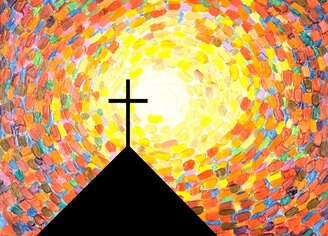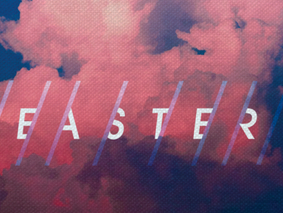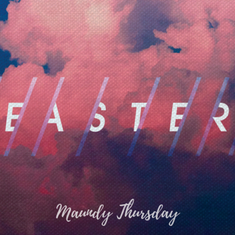 Mark 16:2-8 Out of the four Gospels, Mark has the shortest account of the first Easter. I think this was a story-telling device used by the apostle Peter. John Mark, the gospel writer, had traveled with Paul and Barnabas but had ended up as a companion of Peter. There is no telling how many times Mark had listened to Peter tell his story about Jesus. If, as I suppose, the Gospel of Mark is Mark’s recollection of Peter’s story, then this ending is the all-time greatest “come back tomorrow to hear some more” story. Imagine listening to Peter tell his story. You had heard about this new religion that has been growing for years. And then you were surprised to find out that you knew some Christians yourself. And they invited you to meet someone who knew Jesus. It is going to take about two and a half to three hours to tell. It is the greatest story ever told and Peter tells it very well. It is full of human drama, ups and downs, twists and turns. And toward the end you hear Peter’s tearful confession of denying Jesus three times. You are stunned to hear that someone so wonderfully loving as Jesus could be executed as a criminal. How could that happen? And then you hear these seven verses, Mark 16:2-8. The three women go to the tomb and find the stone rolled away. There is a man sitting inside the tomb. He tells the women, “Don’t be alarmed! You are looking for Jesus from Nazareth, who was nailed to a cross. God has raised him to life, and he isn’t here. You can see the place where they put his body. Now go and tell his disciples, and especially Peter, that he will go ahead of you to Galilee. You will see him there, just as he told you.” When the women ran from the tomb, they were confused and shaking all over. They were too afraid to tell anyone what had happened. “Wait! What? Peter, how did you find out? When did the women finally tell you? Did you go to Galilee? Did you see him? What happened?” Peter answers, “Come back tomorrow night and I will tell you more.” There is so much more!
0 Comments
 Mark 16:1 I call this “Dark Saturday” for two reasons. First, Jesus is in his tomb. There are stories about what Jesus did while he was dead but none of them are biblical. The Apostles’ Creed Ecumenical Version says that “he descended to the dead” which is not very enlightening. Second, the Bible tells us very little about that Saturday after Jesus was crucified. Matthew tells us that the chief priests and Pharisees got permission from Pilate to guard the tomb of Jesus. Luke says, “They rested on the Sabbath.” John says nothing about that day. And Mark tells us that after sundown on Saturday “Mary Magdalene, Salome, and Mary the mother of James bought some spices to put on Jesus’ body.” Mary Magdalene was not a former prostitute. Neither is there any indication that she was the woman who anointed Jesus’ feet. Nor is there any reason to conflate her with Mary the sister of Martha and Lazarus. Luke 8:1-3 lists Mary Magdalene with Joanna and Susanna as women who had been healed by Jesus and were using what they owned to help Jesus and his disciples. This passage also says that Mary once had seven demons in her. Magdala, for which she gets the moniker Magdalene, was a city on the western shore of Lake Galilee. Salome is identified in Matthew 27:56 as the mother of the sons of Zebedee. The sons of Zebedee are James and John. John 19:25 identifies Salome as the sister of Jesus’ mother, Mary. That would mean that Salome is Jesus’ aunt and that James and John are his first cousins. Mary the mother of James is almost certainly also Jesus’ mother. James, the brother of Jesus, was well known in the church as the first bishop of Jerusalem. I am not sure why Mark refers to Mary as the mother of James and not as the mother Jesus. My supposition is that Peter, from whom Mark received this first-hand account of Jesus, always wanted to include James, the leader of the church in Jerusalem, in his telling of the gospel story.  Mark 15:1-47 We call it “Good Friday” because it was good for us. Jesus died for us, for the forgiveness of our sins which have earned us death (see Romans 6:23). This was God’s plan. Read Jesus’ description of his role as the good shepherd (John 10:7-18). “I came so that everyone would have life, and have it in its fullest.” “The Father loves me, because I give up my life, so that I may receive it back again. No one takes my life from me. I give it up willingly! I have the power to give it up and the power to receive it back again, just as my Father commanded me to do.” Jesus remained silent before Pilate because if he had offered any defense of himself then Pilate would have been unwilling to have Jesus crucified. The whipping given to a condemned person was meant to weaken them before they were crucified. Carrying their own cross was also a method of weakening the condemned. Simon of Cyrene is mentioned for helping to carry Jesus’ cross but also for the sake of his sons Alexander and Rufus who were known in the church. Jesus was offered a mixture of wine and drugs designed to ease the shock of crucifixion. But Jesus refused to drink it – he was taking our suffering upon himself and he wanted to make sure that he got all of it. (Stop and think about that.) They nailed Jesus to a cross at about mid-morning (9 am). At about noon Jesus shouted out, “My God, my God, why have you deserted me?” Jesus is using the words of Psalm 22 to express what is happening to him. Many people believe that God had actually deserted Jesus because Jesus had become a sinner by taking our sins upon himself. But that is not our experience of being sinners. We are sinners but God does not desert us. If God deserted sinners, then none of us would have ever known God. But sin does separate us from God – it moves us away from God and makes it harder for us to recognize God’s presence in our lives. Jesus was experiencing this distance from God for the first time in his life. It was one human experience that Jesus had never had – separation from God through sin. (If you want to know how this plays out then read all of Psalm 22.) It is my belief that Jesus did not die from crucifixion but from separation from God because of our sins – this means that no one is more guilty of killing Jesus than we are. Jesus died and the curtain in the temple tore in two from top to bottom. The Jewish temple in Jerusalem had six segregated parts: 1) The outer court or Court of the Women where any Jewish person could go (the women had a special door where they could stand and look into the inner court to see a sacrifice that was being made specifically for them). 2) The Court of the Israelites where Jewish men could go inside the inner court. 3) The Court of the Priests where any priest could go at any time. 4) The area of sacrificing where only priests who were working in the temple could go. 5) The Holy Place where only priests could go who were doing very specific jobs. 6) The Holy of Holies, the throne of God, where only the High Priest could go only one day a year. The curtain separated the Holy Place from the Holy of Holies or in other words in separated the people from God. The tearing of the curtain shows that God is now directly available to the people – there are no more segregated levels of access. A Roman army officer watched Jesus die. He had probably watched many people die in battle, on crosses, and other ways. But watching Jesus die was different and he knew it. He said, “This man really was the Son of God!” Jesus’ friends now had less than three hours to get him down from the cross, clean his body, and find a place to put him before the beginning of the Sabbath at sunset. Joseph of Arimathea went to Pilate to ask permission to do this. Pilate was surprised that Jesus was already dead. Crucified people sometimes lived for days hanging on a cross. Jesus and the two criminals were crucified in an old rock quarry just outside the walls of Jerusalem. Joseph of Arimathea and other Jews had begun using the old quarry as a place of burial – rock that was not good enough for building was good enough for tombs. Joseph had Jesus’ body prepared and entombed there less than two hundred feet from where he was crucified.  Mark 14:12-72 Three major stories happen here on Thursday: 1. The Last Supper The Festival of Thin Bread (Passover) begins at sundown on Thursday. Jesus and his disciples gather in an upper room in Jerusalem for the Passover meal and the traditional Jewish liturgy that goes along with the meal. During the meal Jesus changed the meaning of Passover for his followers and established a new agreement between God and God’s people. We call this new agreement Holy Communion, Eucharist, or the Lord’s Supper. It is, for us, a sharing in the life, death, and resurrection of Jesus by making his sacrificed body and blood part of our body and blood, together. We do this together to show that we are also binding ourselves to one another as the living, breathing, working, and loving body of Christ. 2. The Prayer, Betrayal, Arrest, and Questioning of Jesus Jesus leads his disciples to the Mount of Olives and the Garden of Gethsemane where he wrestles in prayer with the sacrifice that God is asking him to make. Jesus comes to the same conclusion that his mother reached some thirty years earlier when God asked her to sacrifice her life: “I will do whatever God wants me to do.” Judas comes with a mob of men armed with swords and clubs and betrays Jesus with a kiss. Jesus is arrested and all of his disciples ran off and left him. Jesus was led off to the house of the high priest and Peter followed at a distance. Jesus is put on trial and questioned before the Jewish council. Finally, the high priest asks Jesus, “Are you the Messiah, the Son of the glorious God?” “Yes, I am!” Jesus answered. 3. Peter’s Denial Peter and all the disciples had sworn that they would never deny knowing Jesus even if it meant they would be killed. But now none are left except Peter and he is keeping his distance from Jesus. A servant girl asserts to Peter, “You were with Jesus from Nazareth!” Peter replied, “That’s not true!” Later she tells others, “This man is one of them!” “No, I’m not!” Peter replied. Later some of the people said to Peter, “You certainly are one of them. You’re a Galilean!” Peter cursed and swore, “I don’t even know the man you’re talking about!” Then the rooster crowed a second time. Three times – because you can’t claim that it was a slip of the tongue, or a mistake, or a moment of weakness. Three times because that is who you are deep down in a place you cannot control and cannot hide. And Peter cried – and we cry with him. |
AuthorWrite something about yourself. No need to be fancy, just an overview. ArchivesCategories |
Location |
Our MissionCaring for the needs of our church and community through prayer, deeds, inspiration and love in the Spirit of Christ.
Sunday Worship: 10 am Adult & Children & Youth Sunday School 9 am First Kids Mother's Day Out (Tuesday & Thursday; 8am to 2pm; Ages 1-3) Rev Pat Bell, Pastor First United Methodist Church Sealy
200 Atchison Street Sealy, Texas 77474 979.885.2223 |
Contact Us |
 RSS Feed
RSS Feed